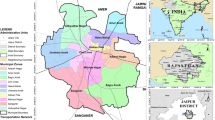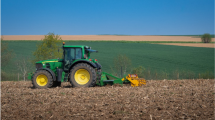Abstract
On ecological vegetation maps, the distribution of vegetation is related to one or more features of the environment. Tolerance, competition, map scales and the environment are discussed with regard to their bearing on the geographical distribution of phytocenoses and their portrayal on maps. There are two types of ecological vegetation maps: those relating the vegetation to one environmental quality, and those with two or more such qualities. The interpretation of ecological vegetation maps is relatively simple when plant communities are related to a single quality of the biotope and difficult but usually more useful when related to several qualities. Perfection is not possible but can be approached asymptotically.
Similar content being viewed by others
References
Anonymous, 1956. Upper Cheyenne River Basin, Wyoming. Bureau of Land Management, Area 3. Cheyenne.
Bailey, R. G., 1976. Ecoregions of the United States. U.S.D.A., Forest Service. Forest & Range Experiment Station. Fort Collins, CO.
Box, E. O., 1981. Macroclimate and plant forms: an introduction to predictive modeling in phytogeography. Dr W. Junk Publ., The Hague. 258 pp.
Christian, C. S. & Stewart, G. A., 1953. General report on survey of Katherine-Darwin region, 1946. Commonwealth Scientific and Industrial Research Organization. Melbourne. Land Research Series No. 1. In pocket.
Davis, J. E., 1943. Southern Florida. Florida Geological Survey, Bulletin, No. 25. In pocket.
Dierschke, H. (ed.), 1977. Vegetation und Klima. Berichte der Internationalen Symposien der Internationalen Vereinigung für Vegetationskunde. J. Cramer Verlag, Vaduz.
Ellenberg, H., 1956. Grundlagen der Vegetationsgliederung, I: Aufgaben und Methoden der Vegetationskunde. Eugen Ulmer Verlag, Stuttgart. 136 pp.
Emberger, L. Gaussen, H. & Rey, P., 1955. Les Landes. Centre National de la Recherche Scientifique, Service de la carte phytogéographique. Paris.
Klinka, K., 1977. Biogeoclimatic units, Nootka-Nanaimo. Ministry of Forests, Information Services Branch. Victoria, B. C.
Küchler, A. W., 1967. Potential natural vegetation of the United States. U.S. Geological Survey, National Atlas, pp. 89–90. Washington, D.C.
Küchler, A. W., 1977. The natural vegetation of California. In: M. G., Barbour & J., Major (eds.), The Terrestrial Vegetation of California. John Wiley & Sons, New York. In pocket.
Mason, H. L. & Langenheim, J. H., 1957. Language analysis and the concept environment. Ecology 38: 325–340.
Mullenders, W., 1954. La végétation du Kaniama. Institut National pour l'Etude Agronomique du Congo Belge. Bruxelles. Série Scientifique, No. 61.
Ozenda, P. (ed.), 1963ff. Documents de cartographie écologique. Grenoble. Université Scientifique et Médicale, Laboratoire de Biologie Végétale.
Ozenda, P. G. & Pautou, G., 1980. Cartographie écologique de l'environment: l'exemple de la région Rhone-Alpes. Bulletin d'Ecologie, 11, 1.
Paleg, L. G. & Aspinall, D., 1981. The physiology and biochemistry of drought resistance in plants. Academic Press, New York. 492 pp.
Richard, L., 1978. Carte écologique des Alpes, feuille Chamonix Thonon les Bains. Documents des cartographie écologique, vol. 20. In pocket.
Ross, J., 1975. Radiative transfer in plant communities. In: J. L., Monteith (ed.), Vegetation and the Atmosphere. Academic Press, New York. 278 pp.
Rutter, A. J., 1975. The hydrologic cycle in vegetation. In: J. L., Monteith (ed.), Vegetation and the Atmosphere. Academic Press, New York. 278 pp.
Seibert, P., 1980. Ökologische Bewertung von homogenen Landschaftsteilen, Ökosystemen und Pflanzengesellschaften. München. Forstwissenschaftliche Fakultät der Universität.
Shantz, H. L. & Zon, R., 1923. Natural vegetation of the United States. U.S. Department of Agriculture, Washington, D.C. Atlas of American Agriculture.
Simpson, G. M., 1981. Water stress on plants. Praeger Publ., New York. 324 pp.
Spetzman, L. A., 1963. Terrain studies of Alaska, Part V: Vegetation. Department of the Army. Office of the Chief of Engineers. Washington, D.C.
Spiers, B., 1974. Dehesas. Internationaal Instituut voor Luchtkartering en Aardkunde. Subdepartment of Vegetation Survey. I.T.C. Enschede.
Story, R., 1967. Vegetation. In: Land of the Isaac-Comet Area, Queensland. Commonwealth Scientific and Industrial Research Organization, Melbourne. Land Research Series, 19. In pocket.
Strong, W. L., 1979. Land district map: Livingstone-Porcupine, south-western Alberta. Alberta Department of Energy and Resources, Resource Evaluation and Planning Division, Edmonton.
Thom, A. S., 1975. Heat exchange in plant communities. In: J. L., Monteith (ed.), Vegetation and the Atmosphere. Academic Press, New York. 278 pp.
Tosi, J. A., 1969. República de Costa Rica, mapa ecológico. Centro Científico Tropical. San José, C.R.
Walter, H., 1976. Die ökologischen Systeme der Kontinente (Biogeosphäre). Fischer Verlag, Stuttgart. 131 pp.
Walter, H., 1977. Vegetationszonen und Klima, 3rd ed. Eugen Ulmer Verlag, Stuttgart. 309 pp.
Walter, H., 1979. Vegetation of the earth and ecological systems of the geo-biosphere. Springer Verlag, Heidelberg. 274 pp.
Walther, K., 1957. Vegetationskarte der deutschen Flusstäler: mittlere Elbe oberhalb Damnatz. Bundesstelle für Vegetationskartierung, Stolzenau an der Weser.
Wieslander, A. E., 1949. The timber stand and vegetation-soil maps of California. U.S. Department of Agriculture, Forest Service. California Forest and Range Experiment Station, Berkeley.
Author information
Authors and Affiliations
Rights and permissions
About this article
Cite this article
Küchler, A.W. Ecological vegetation maps. Vegetatio 55, 3–10 (1984). https://doi.org/10.1007/BF00039975
Accepted:
Issue Date:
DOI: https://doi.org/10.1007/BF00039975




